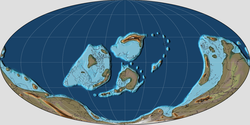Lipeón Formation
The Lipeón Formation is a Telychian to Pridoli geologic formation of southern Bolivia and northwestern Argentina. The formation comprises sandstones and siltstones. Plant fossils comprising rhyniophytes (specifically Aberlemnia, Steganotheca, Tarrantia, Hostinella and Cooksonia) are scattered throughout, with some abundant concentrations on micaceous bedding plains. The fossil flora is the oldest of South America.[1][2] Also present were quite diverse small, irregularly branching fragments possibly the tips of algae such as Buthotrephis or Hungerfordia.[3]
| Lipeón Formation Stratigraphic range: Homerian ~426–423 Ma | |
|---|---|
| Type | Geological formation |
| Underlies | Baritú Formation |
| Lithology | |
| Primary | Sandstone |
| Other | Siltstone |
| Location | |
| Coordinates | 17.8°S 64.8°W |
| Approximate paleocoordinates | 52.8°S 121.7°W |
| Region | Tarija Department Jujuy Province |
| Country | |
| Extent | Oriental |
 Lipeón Formation (Bolivia) | |
Correlations


The Lipeón Formation is laterally equivalent to the Kirusillas Formation.[4][5][6] The formation is a potential source rock for shale oil and shale gas.[7]
Fossil content
The formation has provided the following fossils:
- Ornatosinuitina reyesi
- Slimonia boliviana[8]
- Styliolina sp.
- Lingulata indet.
- Flora
References
- Jarcas stream, Negra Muerta, Sella Valley, Tarija at Fossilworks.org
- Padcaya, Tarija at Fossilworks.org
- Edwards et al., 2015, pp.16-17
- Veizaga Saavedra et al., 2014, p.96
- Pojo at Fossilworks.org
- Hacienda de Tapacari, 10 km from Huari, 120 km S of Oruro at Fossilworks.org
- Veizaga Saavedra et al., 2014, p.99
- Kjellesvig-Waering, 1973
Bibliography
- Edwards, Dianne; Lesley Cherns, and A.J. Raven. 2015. Could land-based early photosynthesizing ecosystems have bioengineered the planet in mid-Palaeozoic times?. Palaeontology 58. 803–837. Accessed 2020-03-19.
- Veizaga Saavedra, Juan G.; Daniel G. Poiré; Gustavo D. Vergani, and José A. Salfity. 2014. Formación Los Monos (Devónico), Cuenca de Tarija: Aproximación Geoquímica y Mineralógica del potencial como Shale Gas y Shale Oil, 93–115. IX Congreso de Exploración y Desarrollo de Hidrocarburos. Accessed 2019-03-03.
- Kjellesvig-Waering, Erik N. 1973. A new Silurian Slimonia (Eurypterida) from Bolivia. Journal of Paleontology 47. 549–550.
Further reading
- R. E. Plotnick. 1999. Habitat of Llandoverian-Lochkovian eurypterids. In A. J. Boucot, J. D. Lawson (eds.), Paleocommunities - a case study from the Silurian and Lower Devonian 106-136
- B. Petriella and R. Suarez Soruco. 1989. Presencia de plantas terrestres, probablemente vosculares, en las formaciones Kirusillas y Tarabuco (Lampayano-Silurico Superior) de Bolivia. Revista Tecnica de YPFB 10:119-121
- C. J. Fischer. 1969. Deux bellerophontacées nouveaux de Bolive. Bulletin de Societé géologique, France 7:605-608